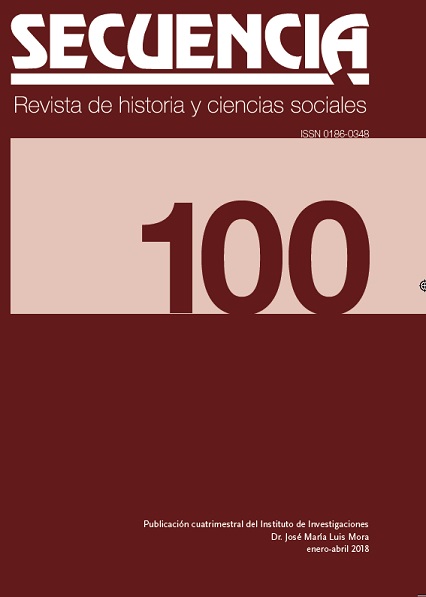Resumen
La reciente “vuelta biográfica” ha proporcionado una riqueza de nuevos temas y metodologías. Aquí se plantean dos preguntas: 1) ¿cuáles son los retos diferentes que enfrenta el biógrafo que desea investigar y escribir la vida de una mujer comparados con el que escribe la biografía de un hom- bre?, y 2) ¿cómo han influido los nuevos temas y métodos en las recientes bio- grafías de mujeres mexicanas? Para apreciar la influencia de esos, se revisan algunas biografías recientes de las vidas de mujeres mexicanas, incluyendo la que está escribiendo la autora del artículo. Se encuentra que han influido de manera positiva en la búsqueda de fuentes, la narrativa, el significado del contexto, y en el trato de los temas de género, subjetividad, identidad, agencia y representación. Estas biografías apuntan a rescatar a las mujeres olvidadas de la historia con tal de establecerlas como sujetos históricos y, así, transfor- mar la escritura de la historia en general.
Citas
Alpern, S., Antler, J., Perry, E. Israels y Scobie, I. W. (1992). Introduction. En S. Al- pern, J. Antler, E. Perry e I. W. Scobie (eds.), The challenge of feminist biography: Writing the lives of modern American women (pp. 1-15). Urbana: University of Illinois Press.
Backscheider, P. R. (2004). Reflections on biography. Oxford: Oxford University Press. Barry, K. (1992). Toward a theory of women’s biography: From the life of Susan B.
Anthony. En T. Iles (ed.), All sides of the subject: Women and biography (pp. 23-35). Nueva York: Teachers College Press.
Bazant, M. (2010). Laura Méndez de Cuenca: Mujer indómita y moderna (1853-1928).
Toluca: Gobierno del Estado de México.
Bazant, M. (2013a). Introducción: la sublime experiencia histórica de la biografía. En M. Bazant (ed.), Biografía: Modelos, métodos y enfoques (pp. 17-38). Zinacantepec: El Colegio Mexiquense.
Bazant, M. (2013b). Lo verdadero, lo verosímil y lo ficticio. En M. Bazant (ed.), Biografía: Modelos, métodos y enfoques (pp. 233-256). Zinacantepec: El Colegio Mexiquense.
Bazant, M. (2015). A feisty woman in nineteenth-century Mexico: Laura Men- dez de Cuenca (1853-1928). Journal of Women’s History, 27(1), 13-27. doi:10.1353/ jowh.2015.0000
Benton, M. (2009). Literary Biography: An introduction. Hoboken: Wiley-Blackwell. Bradu, F. (1992). Antonieta. México: Fondo de Cultura Económica.
Caine, B. (1994). Feminist biography and feminist history. Women’s History Review,
(2), 247-261. doi: http://dx.doi.org/10.1080/09612029400200049
Caine, B. (2010). Biography and History. Nueva York: Palgrave Macmillan.
Cano, G. (2009). Estereotipos de género en la escritura de la biografía de Elena Ariz- mendi. Ponencia presentada en el simposio In First Person: Biography and History in Latin America, Latin American Labor History Conference, Duke Univer- sity, Durham, North Carolina.
Cano, G. (2010). Se llamaba Elena Arizmendi. México: Tusquets.
Chanfrault-Duchet, M. (1991). Narrative structures, social models, and symbolic re- presentations in the life story. En S. Berger Gluck y D. Patai (eds.), Women’s words: The feminist practice of oral history (pp. 77-92). Nueva York: Routledge.
Chassen, F. (1998). Juana Catarina Romero, cacica porfiriana: La mujer y el mito.
Acervos 7, 10-16.
Chassen-López, F. (2008), Patron of Progress: Juana Catarina Romero, Ca- cica of Tehuantepec. Hispanic American Historical Review, 88(3), 393-426. doi:10.1215/00182168-2008-330
Chassen-López, F. (2013). Mitos, mentiras y estereotipos: el reto de la biografía fe- minista. En M. Bazant (ed.), Biografía: Modelos, métodos y enfoques (pp. 149-178). Zinacantepec: El Colegio Mexiquense.
Chassen-López, F. (2014). The Traje de Tehuana as national icon: Gender, ethnicity, and fashion in Mexico. The Americas, 71(2), 281-314. doi: 10.1353/tam.2014.0134
Collingwood, R. G. (1969). The pleasures of doubt: Re-enacting the crime –The li- mits of historical knowledge. En R. Winks (ed.), The historian as detective: Essays on evidence (pp. 513-522). Nueva York: Harper and Row.
Crenshaw, K. W. (1991). Mapping the margins: Intersectionality, identity politics, and violence against women of color. Stanford Law Review, 43(6), 1241-1299. doi:10.2307/1229039
Damousi, J. (1995). Feminist biography. En R. Broome (ed.), Tracing past lives: The writing of historical biography (pp. 33-42). Victoria, Australia: The History Institute. Davis, N. Z. (1983). The return of Martin Guerre. Cambridge: Harvard University Press.
Davis, N. Z. (1988). On the lame. The American Historical Review, 93(3), 572-603. doi:
2307/1868103
Downs, L. L. (2010). Writing gender history (2a ed.). Londres: Bloomsbury Academic. Dosse, F. (2007). El arte de la biografía: entre historia y ficción. México: Universidad
Iberoamericana.
Evans, T. y Reynolds, R. (2012). Introduction to this special issue on biography and life writing. Australian Historical Studies, 43, 147-155. doi: 10.1080/1031461X.2012.652301
Fernández Aceves, M. T. (2013). Voces y silencios de mujeres en política. En M. Ba- zant (ed.), Biografía: Modelos, métodos y enfoques (pp. 179-197). Zinacantepec: El Colegio Mexiquense.
Fernández Aceves, M. T. (2014). Mujeres en el cambio social en el siglo xx mexicano. Mé- xico: ciesas/Siglo XXI Editores.
Ferres, K. (2002). Gender, biography, and the public sphere. En P. France y W. St.
Clair (eds.), Mapping lives: The uses of biography (pp. 303-319). Oxford: Oxford Uni- versity Press.
García, A. L. (1998). Historia de las mujeres del siglo xix: algunos problemas meto- dológicos. En E. Bartra (ed.), Debates en torno a una metodología feminista. México: Universidad Autónoma Metropolitana-Unidad Xochimilco.
Garrison, D. (1992). Two roads taken: Writing the biography of Mary Heaton Vorse.
En S. Alpern, J. Antler, E. I. Perry e I. W. Scobie (eds.), The challenge of feminist biography (pp. 65-78). Urbana: University of Illinois.
Hall, L. B. (2013). Dolores del Río: Beauty in light and shade. Stanford: University of
California Press.
Hamill Jr., H. M. (1971). The status of biography in Mexican historiography. En Inves- tigaciones contemporáneas sobre historia de México: Memorias de la tercera reunión de historiadores mexicanos y norteamericanos (pp. 285-304). México: unam/El Colegio de México/Universidad de Texas en Austin.
Hamilton, N. (2007). Biography: A brief history. Cambridge: Harvard University Press. Hamilton, N. (2017). Biography as corrective. En H. Renders, R. De Haan y S. Har- msma (eds.), The biographical turn: Lives in history (pp. 15-30). Abingdon, Oxon:
Routledge.
Harris, A. K. (2009). Why biography. American Historical Review, 114(3), 625-630. Re- cuperado de http://www.jstor.org/stable/30223924
Heilbrun, C. (1988). Writing a woman’s life. Nueva York: Norton.
Krauze, E. (1976). Caudillos culturales de la revolución mexicana. México: Siglo XXI. Krauze, E. (1 de noviembre de 1983). Invitación a la biografía. Vuelta, 84, 57-59. Krauze, E. (2012). El arte de la biografía [epub]. México: Mondadori Random House. Krauze, E. (2013). El club de los biógrafos. En M. Bazant (ed.), Biografía: Modelos,
métodos y enfoques (pp. 11-15). Zinacantepec: El Colegio Mexiquense.
Lässig, S. (2004). Towards a biographical turn? Biography in modern historiography
–Modern historiography in biography. German Historical Institute Bulletin, 35, 142-
Recuperado de https://www.ghidc.org/fileadmin/user_upload/GHI_Wash- ington/Publications/Bulletin35/35.147.pdf
Lee, H. (2005). Virginia Woolf ’s nose: Essays on biography. Princeton: Princeton Uni- versity Press.
Lee, H. (2009). Biography: A very short introduction. Oxford: Oxford University Press. Mann, S. (2007). The talented women of the Zhang family. Berkeley: University of Ca-
lifornia Press.
Mann, S. (2009). Scene-setting: Writing biography in Chinese history. The American
Historical Review, 114(3), 631-639. doi: 10.1086/ahr.114.3.631
Mann Trofimenkoff, S. (1985). Feminist biography. Atlantis, 10(2), 1-9.
Margadant, J. B. (2000). The new biography: Performing femininity in nineteenth century
France. Berkeley: University of California.
Meyerowitz, J. (2008). Forum: A History of “Gender”. American Historical Review,
(5), 1346-356. Recuperado de http://www.jstor.org/stable/30223445
Miller, J. C. (2014). A historical appreciation of the biographical turn. En L. A. Lind- say y J. W. Sweet (eds.), Biography and the black Atlantic (pp. 12-47). Filadelfia: Uni- versity of Pennsylvania Press.
Nasaw, D. (2009). Introduction: Historians and biography. American Historical Re- view, 114(3), 573-578. Recuperado de http://www.jstor.org/stable/30223918
Painter, N. I. (1997). Writing biographies of women. Journal of Women’s History, 9(2),
-163. doi: 10.1353/jowh.2010.0562
Palacio, C. del. (2010). Leona. México: Suma.
Palacio, C. del (2013). La labor detectivesca y la creatividad en la biografía novelada y la novela histórica. En M. Bazant (ed.), Biografía: Modelos, métodos y enfoques (pp.
-324). Zinacantepec: El Colegio Mexiquense.
Quintanilla, S. (2013). El arte de la biografía histórica. En M. Bazant (ed.), Biografía: Modelos, métodos y enfoques (pp. 259-277). Zinacantepec: El Colegio Mexiquense.
Renders H., De Haan, B. y Harmsma, J. (2017). The biographical turn: Biography as critical method in the humanities and in society. En H. Renders, B. de Haan y J. Harmsma (eds.), The biographical turn: Lives in history (pp. 3-11). Abingdon, Oxon: Routledge.
Salvatore, N. (2004). Biography and social history: An intimate relationship. Labour
History, 87, 187-192. doi: 10.2307/27516005
Schiff, S. (2010). Cleopatra: A life. Nueva York: Little, Brown and Co.
Scott, J. (1986). Gender: A useful category of analysis. American Historical Review,
(5), 1053-1075. doi: 10.2307/1864376
Strouse, J. (1986). The real reasons. En W. Zinsser (ed.), Extraordinary lives: The art and craft of American biography (pp. 163-195). Boston: Houghton Mifflin.
Suárez Argüello, A. R. (2013). De cómo la biografía puede enriquecerse con la lite- ratura. En M. Bazant (ed.), Biografía: Modelos, métodos y enfoques (pp. 279-294). Zinacantepec: El Colegio Mexiquense.
Taylor, B. (2009). Separations of soul: Solitude, biography, history. American Histori- cal Review, 114(3), 640-651. Recuperado de http://www.jstor.org/stable/30223926
Townsend, C. (2006). Malintzin’s choices: An Indian woman in the conquest of Mexico.
Albuquerque: University of New Mexico Press.
Vaughan, M. K. (2013). La labor creativa en la construcción biográfica: el equilibrio entre el sujeto y su contexto histórico. En M. Bazant (ed.), Biografía: Modelos, mé- todos y enfoques (pp. 55-76). Zinacantepec: El Colegio Mexiquense.
Vaughan, M. K. (2015). Portrait of a young painter: Pepe Zúñiga and Mexico city’s rebel generation. Durham: Duke University Press.
Wagner-Martin, L. (1994). Telling women’s lives: The new biography. New Brunswick: Rutgers University Press.
Ware, S. (2010). Writing women’s lives: One historian’s perspective. Journal of Interdis- ciplinary History, XL(3), 413-425. doi: 10.1162/jinh.2010.40.3.413
Weeks, Ch. A. (2005). The Juárez myth in Mexico. Tuscaloosa: University of Alabama
Press.
Woolf, V. (1942). The art of biography. En The Death of the moth and other essays (pp.
-196). Nueva York: Harcourt, Brace.
Aquellos autores/as que tengan publicaciones con esta revista, aceptan los términos siguientes:
- Los autores/as conservarán sus derechos de autor y garantizarán a la revista el derecho de primera publicación de su obra, el cuál estará simultáneamente sujeto a la Licencia de reconocimiento de Creative Commons Atribución-NoComercial 4.0 Internacional que permite a terceros compartir la obra siempre que se indique su autor y su primera publicación esta revista.
- Los autores/as podrán adoptar otros acuerdos de licencia no exclusiva de distribución de la versión de la obra publicada (p. ej.: depositarla en un archivo telemático institucional o publicarla en un volumen monográfico) siempre que se indique la publicación inicial en esta revista.
- Se permite y recomienda a los autores/as difundir su obra a través de Internet (p. ej.: en archivos telemáticos institucionales o en su página web) antes y durante el proceso de envío, lo cual puede producir intercambios interesantes y aumentar las citas de la obra publicada. (Véase El efecto del acceso abierto).




